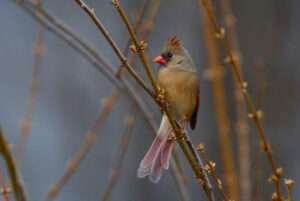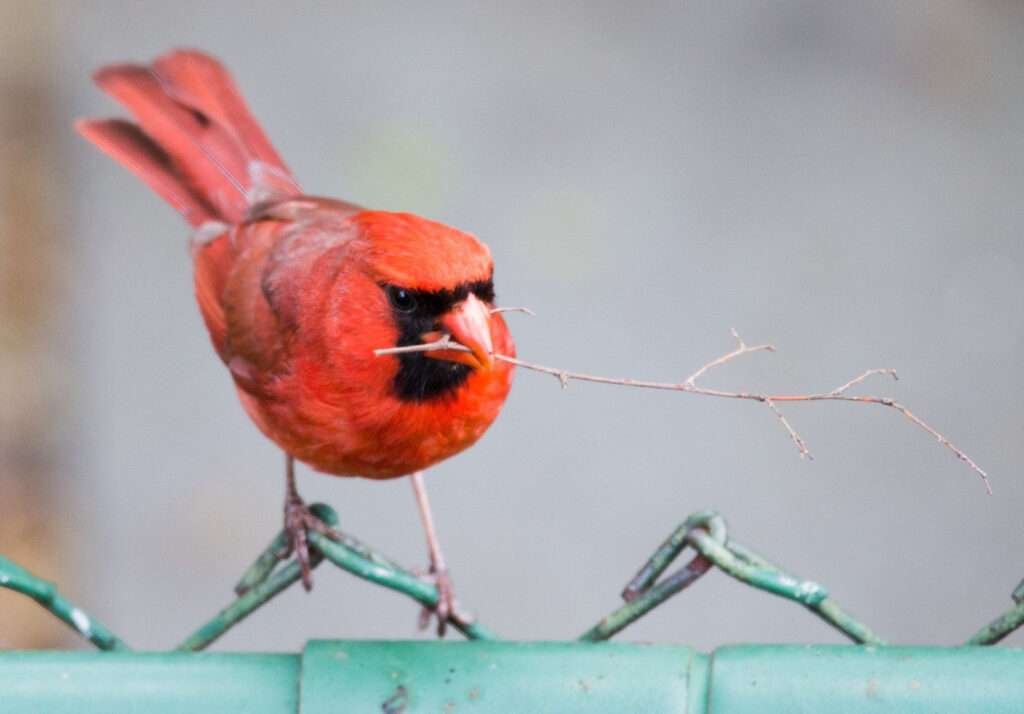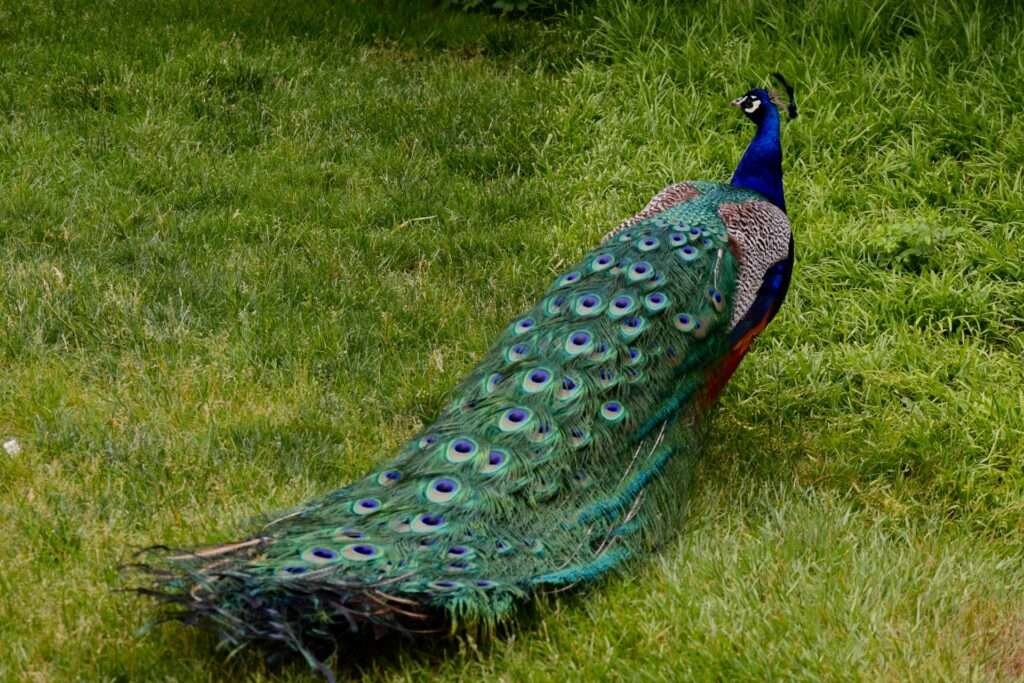The female Cardinal boasts a subdued tan plumage with hints of red. She differs from the male’s vibrant red colouration.
The female Cardinal (Cardinalis cardinalis), often found in North America, is known for her muted yet warm appearance. Unlike the males, she does not exhibit the iconic bright red feathers, but rather a mix of greyish-tan with touches of red on her wings, tail, and crest.
People admire these birds for their striking appearance and melodic songs. With her less conspicuous colouring, the female Cardinal has better camouflage in her environment, which is a useful trait for nesting and avoiding predators. Her subtle beauty makes her a favourite among bird watchers and nature enthusiasts. Despite her less flamboyant colors, the female Cardinal plays a vital role in the mating rituals, as her ability to blend into the surroundings often attracts males, providing a secure site for their offspring.
Physical Appearance
Distinctive Features
Size and Shape: Female Cardinals boast a robust, rounded body. Their short, thick beaks are perfect for cracking seeds. Notice the prominent crest on her head, often raised or lowered, reflecting her mood.- Wingspan: Ranges from 9.8 to 12.2 inches.
- Length: Typically between 8.3 and 9.1 inches.
- Weight: averaging about 1.5 ounces.
Colouration
The colour palette of the female cardinal is a subtle mix. Warm tan and brown shades dominate, with hints of red on her wings and tail. Her face has a soft, greyish touch, while the throat showcases a lighter tone.| Body Part | Colour Description |
|---|---|
| Overall Feathers | Tan to brown, with olive hues |
| Wings and tail | Reddish accents |
| Beak | Bright orange |
Habitat and Distribution
Preferred Habitat
The female cardinal doesn’t stray far from where she feels at home. Her preferred habitat is diverse.- Woodland edges with thickets and shrubs
- Gardens and backyards where bird feeders are common
- Park areas feature a mix of trees and open spaces.
- Dense brushy areas for protection and nesting.

Geographical Range
The geographical range of the female cardinal is extensive. She is mostly seen as:| Region | Features |
|---|---|
| Eastern United States | Year-round presence |
| Southern Canada | Warm months only |
| Northern Mexico | Year-round presence |
| Guatemala | Year-round presence |
| Belize | Year-round presence |
Behaviour
Feeding Habits
Female Cardinals are known for their foraging prowess. They employ a methodical approach to finding food mainly consisting of seeds, fruits, and insects. Their strong beaks make cracking seeds easy. Here’s what their typical diet includes:- Sunflower seeds
- Crushed peanuts
- Assorted berries
- Small insects like beetles and grasshoppers
Nesting Behaviour
The nesting behaviour of female cardinals is a remarkable sight. They take charge of constructing the nest, while males provide materials. Nest placement is strategic, often located in dense shrubbery or small trees for optimal protection.| Nesting Material | Description |
|---|---|
| Twigs | Framework |
| Grasses | Lining |
| Leaves | Camouflage |
Vocalization
Song Patterns
Female cardinals sing various tunes, each with its own unique tempo and rhythm. Their songs often consist of a series of short, clear whistles that ascend and descend in pitch. Interestingly, these patterns can indicate diverse messages. Let’s delve into the aspects that make their melodies exceptional:- Repeated Phrases: Each song contains repetitive phrases that ensure clear communication.
- Songs can vary in length, reflecting the intensity of the message.
- Distinct melodies signal specific scenarios.
Communication Calls
Outside of their melodic singing, female cardinals use calls for day-to-day communication. Calls differ from songs; they are shorter, sharper, and serve functional purposes. The following are some types of calls you might hear:| Call Type | Purpose |
|---|---|
| Alarm Call | Warnings of potential danger |
| Contact Call | Maintains flock cohesion |
| Food Call | Indicates food availability. |
Reproduction
Mating Rituals
The courtship dance of female cardinals is as enchanting as their crimson plumage. Bold males perform to capture the attention of potential mates. They exhibit a variety of displays, from song duets to feather-fluffing spectacles. The ritual often involves the male offering seed to the female in a loving beak-to-beak transfer, symbolizing his ability to provide.Egg Incubation
Following a successful courtship, the female cardinal embarks on the crucial task of incubating her eggs. Her nest, usually hidden in dense foliage, holds 2 to 5 eggs. These treasured ovals blend whites and blues with speckled markings, each requiring about 11 to 13 days of warmth before the hatchlings debut.| Nest Location | Egg Count | Incubation Period |
|---|---|---|
| Dense foliage | 2 to 5 eggs | 11 to 13 days |
Challenges and Threats
Predation
Predators pose a significant risk to female Cardinals. These birds often fall prey to:- Cats: Both domestic and feral cats are notorious hunters.
- Snakes: They stealthily slither into nests for eggs and chicks.
- Birds of Prey: Hawks and owls hunt cardinals for food.
Habitat Loss
Female cardinals need dense foliage for survival. They face habitat threats like:| Threat | Impact |
|---|---|
| Urbanization | Loss of natural homes for buildings and roads. |
| Agriculture | Forests cleared for farmland reduce nesting areas. |
| Climate Change | Alters the availability of vital resources. |
Conservation Efforts
Protection Initiatives
Strict laws safeguard cardinal habitats, and organizations work tirelessly to preserve this species. They focus on land management and predator control.- Banding programs track cardinal populations.
- Education campaigns raise awareness about their plight.
- Restoration projects enhance cardinal ecosystems.
Community Involvement
Local communities play a vital role. They create ‘Bird-Friendly’ spaces in backyards and public parks. Citizen science projects such as bird counts and nest monitoring involve people of all ages.| Action | Impact |
|---|---|
| Building birdhouses | Provides safe nesting for cardinals |
| Planting native flora | Offers natural food and shelter. |
| Keeping cats indoors | Reduces predation risk |
Frequently Asked Questions on Female Cardinals
What Colour Is A Cardinal Female?
Female cardinals typically exhibit dull brown or greyish-tan feathers with subtle red tinges on their wings, tail, and crest.
Is it rare to see a female cardinal?
No, spotting a female cardinal is not rare. Both male and female cardinals are common in their ranges throughout many parts of North America.
What Is The Bird That Looks Like A Cardinal But Is Not?
Pyrrhuloxia is often mistaken for a cardinal due to its similar plumage, but it is a distinct species.
What Bird Looks Similar to a Female Cardinal?
In appearance, the Pyrrhuloxia, or desert cardinal, closely resembles the female Northern cardinal.
Conclusion
Female cardinals brighten our gardens and days with vivid hues and sweet songs. These resilient birds symbolize hope and joy across many cultures. For birdwatchers and nature enthusiasts alike, the presence of a female cardinal is always a welcome sight.





Hi there! nestingfly.com
Did you know that it is possible to send message absolutely in lawful way? We make available a legitimate method of sending messages through contact forms.
Feedback Forms guarantee that messages won’t be marked as spam, since they are considered important.
Come and sample our service without any cost!
We shall deliver up to 50,000 messages to you.
The cost of sending one million messages is $59.
This letter is automatically generated.
Please use the contact details below to get in touch with us.
Contact us.
Telegram – https://t.me/FeedbackFormEU
Skype live:feedbackform2019
WhatsApp +375259112693
WhatsApp https://wa.me/+375259112693
We only use chat for communication.